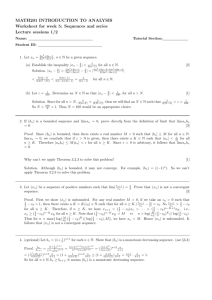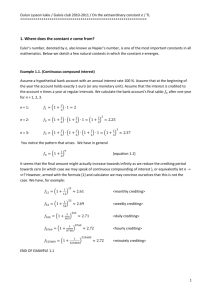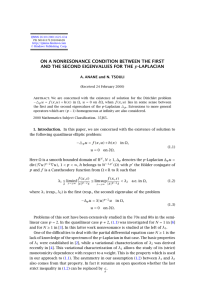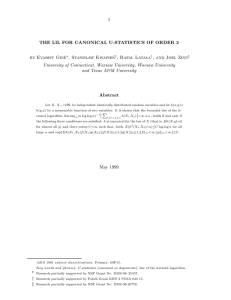Oulun Lyseon lukio / Galois club 2010
advertisement
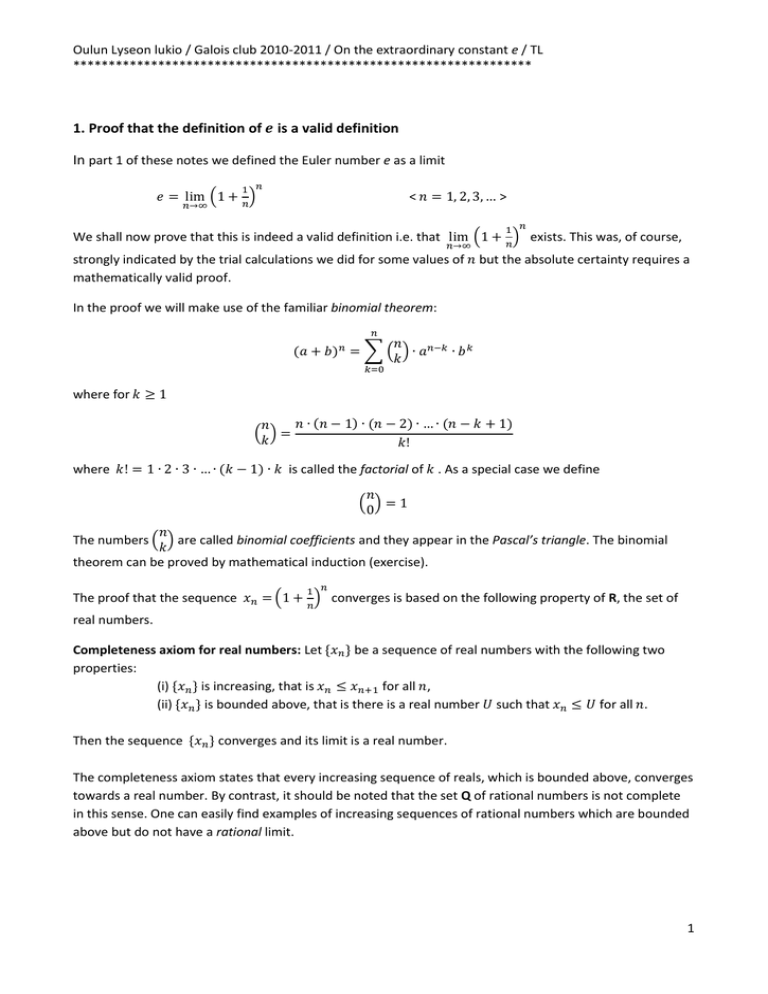
Oulun Lyseon lukio / Galois club 2010-2011 / On the extraordinary constant e / TL
*****************************************************************
1. Proof that the definition of 𝒆 is a valid definition
In part 1 of these notes we defined the Euler number e as a limit
1 𝑛
𝑒 = lim (1 + 𝑛)
< 𝑛 = 1, 2, 3, … >
𝑛→∞
1 𝑛
We shall now prove that this is indeed a valid definition i.e. that lim (1 + 𝑛) exists. This was, of course,
𝑛→∞
strongly indicated by the trial calculations we did for some values of 𝑛 but the absolute certainty requires a
mathematically valid proof.
In the proof we will make use of the familiar binomial theorem:
𝑛
𝑛
(𝑎 + 𝑏) = ∑ ( ) ∙ 𝑎𝑛−𝑘 ∙ 𝑏 𝑘
𝑘
𝑛
𝑘=0
where for 𝑘 ≥ 1
𝑛 ∙ (𝑛 − 1) ∙ (𝑛 − 2) ∙ … ∙ (𝑛 − 𝑘 + 1)
𝑛
( )=
𝑘
𝑘!
where 𝑘! = 1 ∙ 2 ∙ 3 ∙ … ∙ (𝑘 − 1) ∙ 𝑘 is called the factorial of 𝑘 . As a special case we define
𝑛
( )=1
0
𝑛
The numbers ( ) are called binomial coefficients and they appear in the Pascal’s triangle. The binomial
𝑘
theorem can be proved by mathematical induction (exercise).
1 𝑛
The proof that the sequence 𝑥𝑛 = (1 + 𝑛) converges is based on the following property of R, the set of
real numbers.
Completeness axiom for real numbers: Let {𝑥𝑛 } be a sequence of real numbers with the following two
properties:
(i) {𝑥𝑛 } is increasing, that is 𝑥𝑛 ≤ 𝑥𝑛+1 for all 𝑛,
(ii) {𝑥𝑛 } is bounded above, that is there is a real number 𝑈 such that 𝑥𝑛 ≤ 𝑈 for all 𝑛.
Then the sequence {𝑥𝑛 } converges and its limit is a real number.
The completeness axiom states that every increasing sequence of reals, which is bounded above, converges
towards a real number. By contrast, it should be noted that the set Q of rational numbers is not complete
in this sense. One can easily find examples of increasing sequences of rational numbers which are bounded
above but do not have a rational limit.
1
Oulun Lyseon lukio / Galois club 2010-2011 / On the extraordinary constant e / TL
*****************************************************************
1
𝑛
It now suffices to prove that the sequence 𝑥𝑛 = (1 + )𝑛 has the two properties (i) and (ii) stated in the
completeness axiom. This is done in the following two lemmas.
1
Lemma 1.1. The sequence 𝑥𝑛 = (1 + 𝑛)𝑛 is increasing, that is 𝑥𝑛 ≤ 𝑥𝑛+1 for all 𝑛.
1
1
Proof: We use the binomial theorem to expand 𝑥𝑛 = (1 + 𝑛)𝑛 and 𝑥𝑛+1 = (1 + 𝑛+1)𝑛+1 .
We have
𝑛
1
1 𝑘
1 𝑛(𝑛 − 1) 𝑛(𝑛 − 1)(𝑛 − 2)
𝑛!
𝑛
𝑥𝑛 = (1 + )𝑛 = ∑ ( ) ∙ 1𝑛−𝑘 ∙ ( ) = 1 + 𝑛 ∙ +
+
+ ⋯+
2
3
𝑘
𝑛
𝑛
𝑛
2! ∙ 𝑛
3! ∙ 𝑛
𝑛! ∙ 𝑛𝑛
𝑘=0
which simplifies by division into factors to
𝑥𝑛 = 1 + 1 +
1
1
1
1
2
1
1
2
𝑛−1
(1 − ) + (1 − ) (1 − ) + ⋯ + (1 − ) (1 − ) … (1 −
)
2!
𝑛
3!
𝑛
𝑛
𝑛!
𝑛
𝑛
𝑛
Similarly we have
𝑥𝑛+1 = 1 + 1 +
1
1
1
1
2
1
1
𝑛
(1 −
) + (1 −
) (1 −
)+ ⋯+
(1 −
) … (1 −
)
2!
𝑛+1
3!
𝑛+1
𝑛+1
(𝑛 + 1)!
𝑛+1
𝑛+1
When comparing these two expansions we observe that (1) both consist of positive terms, (2) the two first
terms are the same, (3) from the third term onwards every term in the first expansion is smaller than the
𝑘
𝑘
corresponding term in the second expansion, because (1 − 𝑛) < (1 − 𝑛+1) and finally (4) the latter
expansion contains one extra term at the end having no counterpart in the first expansion. Therefore we
conclude that 𝑥𝑛 < 𝑥𝑛+1 .
QED
1
Lemma 1.2. The sequence 𝑥𝑛 = (1 + 𝑛)𝑛 is bounded above.
Proof: We prove that 𝑥𝑛 < 3 for all 𝑛.
𝑘
From the expansion of 𝑥𝑛 in the preceding proof we see, because (1 − 𝑛) < 1 , that
𝑥𝑛 < 1 + 1 +
1 1
1
+ +⋯+
2! 3!
𝑛!
But the right hand side can be estimated above by geometric sums as follows
1+1+
1 1
1
1
1
1
1
+ + ⋯+ = 1 + 1 + +
+
…+
2! 3!
𝑛!
2 2∙3 2∙3∙4
2∙3∙…∙𝑛
1
1
1
1
1
< 1 + (1 + +
+
…+
)<1+
=3
2 2∙2 2∙2∙2
2 ∙ 2 ∙ …∙ 2
1 − 1/2
QED
2
Oulun Lyseon lukio / Galois club 2010-2011 / On the extraordinary constant e / TL
*****************************************************************
2. An alternative definition of 𝒆
Consider the sequence of numbers 𝑦𝑛 defined by
𝑦𝑛 = 1 + 1 +
1 1
1
+ + ⋯+
2! 3!
𝑛!
The sequence 𝑦𝑛 is clearly increasing. Furthermore, in the proof of lemma 1.2 we showed in fact
that 𝑦𝑛 < 3 for all 𝑛 . Hence 𝑦𝑛 is convergent. The simplified binomial expansion of
1
𝑛
𝑥𝑛 = (1 + )𝑛
suggests strongly that
lim 𝑦𝑛 = lim 𝑥𝑛 = 𝑒 .
𝑛→∞
𝑛→∞
Playing on the calculator can easily convince us of the truth of this statement but its rigorous proof
is quite a hard nut and will be skipped here.
Lemma 2.1. The Euler’s 𝑒 number can be represented as an infinite sum
𝑒 =1+1+
1 1
+ + ⋯ = lim 𝑦𝑛
𝑛→∞
2! 3!
Indeed, the sequence 𝑦𝑛 converges very much faster towards 𝑒 than 𝑥𝑛 . In the table below we
have calculated the approximate values of the ratio of errors for some values of 𝑛 .
𝑛
5
10
12
⌈𝑥𝑛 − 𝑒⌉
⌈𝑦𝑛 − 𝑒⌉
142
4 560 000
609 000 000
3
Oulun Lyseon lukio / Galois club 2010-2011 / On the extraordinary constant e / TL
*****************************************************************
3. The exponential function 𝒇(𝒙) = 𝒆𝒙
The paramount mathematical importance of the Euler’s number 𝑒 derives mostly from the rich
variety of nice properties possessed by the 𝑒-based exponential function 𝑓(𝑥) = 𝑒 𝑥 .
𝑥 𝑛
Lemma 3.1. For all real numbers 𝑥 we have 𝑒 𝑥 = lim (1 + 𝑛)
𝑛→∞
Proof: We have
𝑥 𝑛
1
𝑛
1
𝑛/𝑥 𝑥
lim (1 + 𝑛) = lim (1 + 𝑛/𝑥) = lim [ (1 + 𝑛/𝑥)
𝑛→∞
𝑛→∞
𝑛→∞
] = 𝑒 𝑥,
because the expression in the square brackets converges to 𝑒.
QED
As for 𝑒 itself we can also give an alternative (and much more useful) definition for 𝑒 𝑥 in terms of an infinite
sum – a power series as it is usually called.
Lemma 3.2.
For all real numbers 𝑥 we have
∞
𝑥2 𝑥3
𝑥𝑘
𝑒 =1+𝑥+ + +⋯= ∑
2! 3!
𝑘!
𝑥
𝑘=0
Justification: Analogously to the proof of lemma 1.1, apply the binomial theorem to expand the power
𝑥 𝑛
(1 + 𝑛) .
*
*
*
*
*
4


